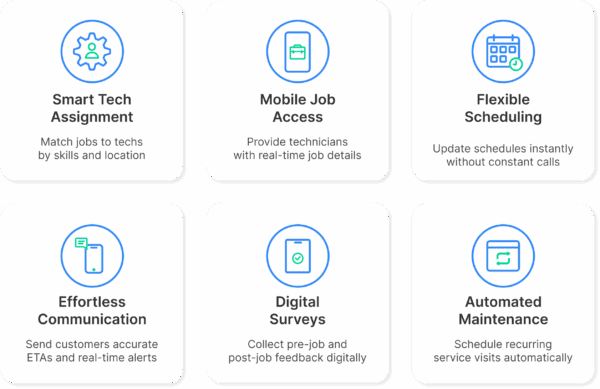
There’s a daily tug-of-war in HVAC businesses between what the field needs and what the office can actually deliver.
Technicians want clarity, dispatchers want control, and customers just want someone to show up on time and fix the problem without excuses. And somewhere in the middle, you’ve got team leads trying to handle schedule gaps, customer complaints, and job updates that arrive too late.
A shared calendar and a phone line clearly aren’t enough. Not when one late arrival triggers a full-day cascade of overtime, angry reviews, and missed jobs.
That’s the gap dispatch software is supposed to close. But not all tools are built for HVAC’s realities like emergency calls, skill mismatches, long drive times, and customers who aren’t home. Let’s dig into what real-time HVAC dispatch actually means, and why it’s more than just dots on a map.
What Is HVAC Dispatch Software?
HVAC dispatch software coordinates field technicians, jobs, and customer information from a centralized system. It replaces phone calls, spreadsheets, and disconnected apps with a clean digital workflow.
In field service operations, dispatch software acts as the operational nerve center. It connects customer requests to technician skills, routes to calendars, and job progress to office visibility in real time.
For HVAC teams, that means:
- Assigning the right tech to the right job based on skills and location
- Giving techs their full job details and updates through mobile apps
- Letting dispatchers shift schedules instantly without phone calls
- Keeping customers in the loop with accurate ETAs and alerts
- Capturing pre- and post-job surveys digitally without paper
- Automating recurring maintenance visits without manual tracking
“Software” isn’t the win here. The win is knowing where your people are, what they’re doing, and what’s falling behind, before it becomes a problem.

Why Real-Time Dispatching Is the Missing Link in HVAC Operations
In an industry where labor costs eat up a significant chunk of total business expenses, dispatch inefficiency becomes not just annoying but also costly. Here’s how HVAC dispatch software helps you avoid that:
Live Technician Tracking & Job Status Updates
If a tech runs late, you don’t want to find out when the next customer is already frustrated. With live GPS, dispatchers can see where someone is and whether they’re stuck in traffic or still finishing up. Paired with real-time status updates (like on-site, in-progress, or completed), it gives you a live picture of what’s happening without constant check-ins. It also makes it easier for supervisors to spot where time’s slipping and keep things on track.
“One technician on Reddit shared that their app wipes job data after entry. Imagine finishing a job only to find the data never synced.”
✅ The right software prevents these failures by logging everything as it happens—before it creates another mess.
Real-Time Communication & Alerts
Asking for updates through calls and texts gets messy. Arrivy’s Smart dispatch system includes built-in two-way messaging and automated alerts. Say you need to reschedule or report a no-show, the right person gets the update right away, no follow-ups needed.
You also avoid the blame game. Every message, ping, and update is logged automatically, so there’s always a record to fall back on. That alone saves a lot of finger-pointing when things get hectic.
Instant Job Reassignment
Plans often change in the field without prior notice. For example, a technician could call in sick, a job might run longer than expected, or a customer could cancel while you have already dispatched someone. To face this uncertainty, drag-and-drop job dashboard lets you reassign tasks in seconds based on availability, skills, or geography.
And when reassignment happens, route plans and estimated arrival times update automatically. There’s no need for last-minute calls to anyone while you stay compliant with SLAs, avoiding overtime, and keeping customers happy.
Digital Proof of Work
With mobile apps, technicians can upload photos, fill out checklists, collect signatures, and mark jobs as complete before they leave the site. This real-time documentation reduces disputes and gives office teams instant visibility into what was done.
82% of field service companies rely on technicians to upsell additional services. But upsells only land when customers trust what they’re shown. A checklist with before/after photos and diagnostics gives the customer confidence in what the tech recommends. That kind of proof can turn a $200 repair into a $5,000 replacement.

With Arrivy dispatch software, there’s no more printing out work orders, calling to confirm addresses, or writing notes. Everything happens in a paper-free environment, and accountability improves because expectations are clear and logged.
Technician Experience in the Field
Technicians are the face of your business. And nothing kills their morale (and performance) more than being kept in the dark.
Technicians commonly complain, “I can’t see my schedule because it’s always changing.” That’s not just annoying but also makes it impossible for them to plan the day, prep tools, or even grab lunch.
In one Reddit rant, a technician shared how unpredictable scheduling not only made him late for personal commitments but also led to tension with dispatchers. When communication breaks down, you can’t expect accountability. View Reddit thread →
But with real-time mobile apps:
- Techs view their day’s schedule and job details instantly
- Navigate using optimized routes
- See notes, photos, and customer history
- Upload images and collect digital signatures
- Close jobs from the field with a few taps
- This increases autonomy, accountability, and pride in work.
Real-Time Benefits for Dispatchers & Supervisors
Dispatchers and ops managers manage the flow of the entire day. But when they rely on manual processes or software that’s slow, unreliable, or glitchy, their job becomes impossible.
Arrivy’s real-time dashboard helps dispatchers:
- See live job statuses and technician availability
- Ability to filter by job type, region, technician, or status
- Reassign work instantly when priorities shift
- Spot delays and reroute before SLA violations occur
And supervisors don’t have to wait until the day’s over to figure out what went wrong. They can step in earlier and actually support their teams when it counts.
The ROI is crystal clear
75% of service companies using mobile tools report increased employee productivity. Read more →
How Dispatch Software Keeps Customers in the Loop
Today’s homeowners expect the same real-time updates they get from Amazon and Uber. HVAC dispatch platforms meet this demand by offering:
- Real-time ETA tracking
- Arrival and delay notifications
- Text alerts when a technician is en route
According to consumer review data, 55% of negative HVAC reviews stem from delays or missed appointments.
If your system can proactively notify customers when techs are late or rerouted, you avoid complaints and build trust.
And trust is what drives loyalty. 60% of customers say they’d take a trusted technician’s advice and even follow him to a new company.
Software Integrations That Power Dispatch Efficiency
Disconnected tools slow everything down. When your FSM software doesn’t sync with accounting, CRM, or inventory tools, you lose time to double entry, phone calls, and dropped details.
A modern HVAC dispatch solution integrates with:
- CRMs for customer details and history access
- Communication tools like Slack for messaging teams
- Inventory tools for part tracking and job prep
- Google Calendar/Outlook for schedule management
- Accounting tools like QuickBooks and Square for instant payments
When contract maintenance plans can generate $500–$1,500 per customer per year, every missed or delayed job is a leak in your revenue bucket. Tight integration means faster invoicing, accurate scheduling, less back-office busywork, and more jobs completed per day.

The Bigger Picture
If you zoom out a bit, the opportunity is massive. U.S. consumers spend $10B+ each year on HVAC repair and maintenance. But only 30% schedule preventive maintenance (like regular tune-ups or seasonal servicing). That means 70% wait until something breaks before calling for help. There’s a gap that well-run HVAC companies can fill.
Right now, most companies are chasing emergency repairs and replacements, which is reactive work. But there’s huge untapped potential in proactive maintenance plans, which are more predictable, more profitable, and better for customer loyalty.
But scaling that kind of service requires reliable systems. Manual dispatching just can’t keep up. It breaks under pressure, slows down coordination, and leaves teams scrambling. To deliver preventive care at scale and stand out in a $47.8B market for predictive maintenance, you need tools built for real-time visibility, flexible job management, and repeatable workflows.
If your HVAC company can run smoothly and at scale (with real-time dispatching, clear scheduling, etc.), you can offer these services reliably and at volume.
With the right systems, there’s a wide open lane for HVAC companies to scale preventive care and win recurring business.
Final Thoughts
The average HVAC business is juggling labor shortages, rising operational costs, and high customer expectations. With real-time dispatch software, teams can prevent technician overload, reduce no-shows, and stay on top of job progress without constant check-ins.
Winning in the HVAC industry requires equipping your team with the visibility, tools, and coordination they need to perform at their best every hour of every day. If your dispatch process still depends on spreadsheets or glitchy mobile apps, it’s time for a change.
